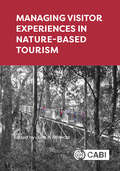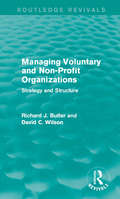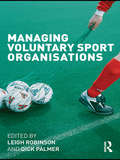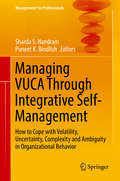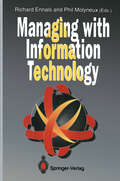- Table View
- List View
Managing Visitor Attractions
by Alan FyallVisitor attractions represent a complex sector of the tourism industry and are the catalytic focus for the development of tourism infrastructure and services. The third edition of this successful text investigates these issues further and provides more solutions and suggestions for the present and future. Now in its third edition, Managing Visitor Attractions has been fully revised and updated to include new content on increased visitor numbers, new destinations and attractions, social media, overtourism, environmental awareness and the experience economy. The book includes case studies on topics such as overtourism at natural attraction sites, new attraction development in Egypt, dark tourism in Latin America, dementia-friendly attractions, and manging sporting venues as attractions. New chapters include the role of the visitor attraction manager, managing safety and risk, themed attractions and storytelling, and digital marketing, among many others. With contributions from around the world, this is an essential text for undergraduate and postgraduate students of visitor attraction management, written by subject specialists with a wealth of experience in this field.
Managing Visitor Attractions
by Alan Fyall Brian Garrod Anna Leask Stephen WanhillVisitor attractions represent a complex sector of the tourism industry and are the catalytic focus for the development of tourism infrastructure and services. The third edition of this successful text investigates these issues further and provides more solutions and suggestions for the present and future. Now in its third edition, Managing Visitor Attractions has been fully revised and updated to include new content on increased visitor numbers, new destinations and attractions, social media, overtourism, environmental awareness and the experience economy. The book includes case studies on topics such as overtourism at natural attraction sites, new attraction development in Egypt, dark tourism in Latin America, dementia-friendly attractions, and manging sporting venues as attractions. New chapters include the role of the visitor attraction manager, managing safety and risk, themed attractions and storytelling, and digital marketing, among many others. With contributions from around the world, this is an essential text for undergraduate and postgraduate students of visitor attraction management, written by subject specialists with a wealth of experience in this field.
Managing Visitor Attractions
by Brian Garrod Stephen WanhillVisitor attractions represent a complex sector of the tourism industry and are the catalytic focus for the development of tourism infrastructure and services. As this area grows, there are still many questions to be answered and issues to be understood – such as what visitor attractions actually are, what forces drive their development, who visits them and why, how they are funded, and what the numerous day-to-day challenges are in respect of their management andmarketing. The second edition of this successful text investigates these issues further and provides more solutions and suggestions for the present and future.Now in its 2nd edition, Managing Visitor Attractions: New Directions has been fully revised and updated to include new case studies on attractions in Singapore, seasonal variation,religion-based attractions, HRM issues and heritage tourism. It also includes five new chapterslooking at attraction success and failure, interpretation, school excursions, managing gardensand brand management.Divided into five parts, the book tackles the following core topics:• the role and nature of visitor attractions• the development of visitor attraction provision• the management of visitor attractions• the marketing of visitor attractions• future issues and trendsWith contributions from around the world, this is an essential text for undergraduate andpostgraduate students of visitor attraction management, written by subject specialists with awealth of experience in this field.
Managing Visitor Attractions
by Brian Garrod Stephen WanhillVisitor attractions represent a complex sector of the tourism industry and are the catalytic focus for the development of tourism infrastructure and services. As this area grows, there are still many questions to be answered and issues to be understood – such as what visitor attractions actually are, what forces drive their development, who visits them and why, how they are funded, and what the numerous day-to-day challenges are in respect of their management andmarketing. The second edition of this successful text investigates these issues further and provides more solutions and suggestions for the present and future.Now in its 2nd edition, Managing Visitor Attractions: New Directions has been fully revised and updated to include new case studies on attractions in Singapore, seasonal variation,religion-based attractions, HRM issues and heritage tourism. It also includes five new chapterslooking at attraction success and failure, interpretation, school excursions, managing gardensand brand management.Divided into five parts, the book tackles the following core topics:• the role and nature of visitor attractions• the development of visitor attraction provision• the management of visitor attractions• the marketing of visitor attractions• future issues and trendsWith contributions from around the world, this is an essential text for undergraduate andpostgraduate students of visitor attraction management, written by subject specialists with awealth of experience in this field.
Managing Visitor Experiences in Nature-based Tourism
by Ali Thompson Mick Abbott Karl Agius Mary E. Allen George Ariya Rocío Blanco-Gregory Cameron Boyle Robert C. Burns Kadir Çakar Eugenio Conti Fernando Enseñat-Soberanis Sonia Ferrari Peter Fredman Azizul Hassan Stuart Hayes Nicolaia Iaffaldano Woody Lee Tiago Lopes Brent Lovelock Andrés Ried Luci Lusine Margaryan Johnathan Mondragón-Mejía Ana Goytia Prat Haywantee Ramkissoon Francisco Silva Jeffrey C. Skibins Ismail UzutThis book focuses on the experiences of tourists visiting nature-based destinations, exploring current knowledge and providing insights into conceptual issues through the use of empirical evidence from five continents. Presented as three topics, the contents discuss tourism and nature-based experiences by looking at the role and relevance of nature and the uniqueness of such experiences. The book identifies visitor management challenges and provides explanations for the solutions reached. The final section takes a more overarching destination management perspective that transcends the tourism product or business level and focuses on destination and generic issues like indicators or marketing implications. The book also includes research-based case studies which contribute to an overall understanding of the core issues involved in managing visitor experiences in nature-based tourism.
Managing Voluntary and Non-Profit Organizations: Strategy and Structure (Routledge Revivals)
by Richard Butler David C. WilsonDrawing on detailed empirical data and a range of case studies, Managing Voluntary and Non-Profit Organizations, first published in 1990, demonstrates how voluntary organizations formulate strategies for securing funds, providing services, and dealing with other non-profit bodies, public agencies, and the private sector. The central theme is organizational change and how managers have responded, strategically and structurally, to changes to their environment. Using original data, and writing from the broad perspectives of current organization theory, the authors increase our understanding of strategies, structures and designs currently in use in the voluntary sector. Their authoritative text will make essential reading for practising managers in non-profit organizations and for an international audience of academics and students of management, organization theory, and strategy.
Managing Voluntary and Non-Profit Organizations: Strategy and Structure (Routledge Revivals)
by Richard Butler David C. WilsonDrawing on detailed empirical data and a range of case studies, Managing Voluntary and Non-Profit Organizations, first published in 1990, demonstrates how voluntary organizations formulate strategies for securing funds, providing services, and dealing with other non-profit bodies, public agencies, and the private sector. The central theme is organizational change and how managers have responded, strategically and structurally, to changes to their environment. Using original data, and writing from the broad perspectives of current organization theory, the authors increase our understanding of strategies, structures and designs currently in use in the voluntary sector. Their authoritative text will make essential reading for practising managers in non-profit organizations and for an international audience of academics and students of management, organization theory, and strategy.
Managing Voluntary Sport Organizations
by Leigh RobinsonContemporary sport could not function without the involvement of voluntary organizations, from local grass-roots clubs to international agencies such as the International Olympic Committee. Management of this sector continues to undergo profound change, largely in response to the challenges of professionalization and increasing expectations in terms of transparency, accountability and ethical behaviour. This book fills a significant gap in the literature on sport management by setting out the principles and practices necessary for effective management of voluntary sport organizations around the world. In addition to applying and adapting established management strategies and techniques to voluntary sport organizations, this book is the first to fully relate mainstream organizational theory to this important sector of sport management. With contributions from an international team of researchers and management practitioners, the book explores key functional areas such as: governance strategy and planning human resources finance managing change marketing event management risk management. Each chapter discusses best practice and includes case study material, self test questions and guides to further reading. As the only book to outline a professional, theoretically informed and practically focused curriculum for voluntary sport management, this book is essential reading for all students of sport management and all managers working in or alongside the voluntary sector.
Managing Voluntary Sport Organizations
by Leigh Robinson Dick PalmerContemporary sport could not function without the involvement of voluntary organizations, from local grass-roots clubs to international agencies such as the International Olympic Committee. Management of this sector continues to undergo profound change, largely in response to the challenges of professionalization and increasing expectations in terms of transparency, accountability and ethical behaviour. This book fills a significant gap in the literature on sport management by setting out the principles and practices necessary for effective management of voluntary sport organizations around the world. In addition to applying and adapting established management strategies and techniques to voluntary sport organizations, this book is the first to fully relate mainstream organizational theory to this important sector of sport management. With contributions from an international team of researchers and management practitioners, the book explores key functional areas such as: governance strategy and planning human resources finance managing change marketing event management risk management. Each chapter discusses best practice and includes case study material, self test questions and guides to further reading. As the only book to outline a professional, theoretically informed and practically focused curriculum for voluntary sport management, this book is essential reading for all students of sport management and all managers working in or alongside the voluntary sector.
Managing Volunteers: How to Maximize Your Most Valuable Resource
by Nancy SakaduskiVolunteers are the backbone of many an organization. This practical, hands-on guide, filled with useful tips and everyday examples, will help those responsible for volunteers successfully recruit and manage this invaluable resource.Anyone who supervises volunteers will find this book an indispensable guide for navigating the intricacies of managing unpaid workers. Underlying the content is the message that volunteers are a vital part of an organization's workforce and should be treated as valuable members of the team. Volunteers can work alongside paid staff members to help the organization run smoothly and efficiently—and cost effectively. The book is packed with easily implemented advice and proven techniques for successfully handling common situations. Concise and easy to read, it assumes neither previous volunteer management experience nor familiarity with business practices, yet even experienced volunteer managers will come away with fresh ideas and new approaches.To augment her own expertise and increase the diversity of viewpoints, the author interviewed volunteer managers from various types of organizations and shares their stories. Quotes and anecdotes throughout the book help readers relate to common problems and illustrate the challenges and rewards of managing volunteers.
Managing Volunteers: How to Maximize Your Most Valuable Resource
by Nancy SakaduskiVolunteers are the backbone of many an organization. This practical, hands-on guide, filled with useful tips and everyday examples, will help those responsible for volunteers successfully recruit and manage this invaluable resource.Anyone who supervises volunteers will find this book an indispensable guide for navigating the intricacies of managing unpaid workers. Underlying the content is the message that volunteers are a vital part of an organization's workforce and should be treated as valuable members of the team. Volunteers can work alongside paid staff members to help the organization run smoothly and efficiently—and cost effectively. The book is packed with easily implemented advice and proven techniques for successfully handling common situations. Concise and easy to read, it assumes neither previous volunteer management experience nor familiarity with business practices, yet even experienced volunteer managers will come away with fresh ideas and new approaches.To augment her own expertise and increase the diversity of viewpoints, the author interviewed volunteer managers from various types of organizations and shares their stories. Quotes and anecdotes throughout the book help readers relate to common problems and illustrate the challenges and rewards of managing volunteers.
Managing Volunteers in Tourism
by Kirsten Holmes Karen SmithRecent years have seen an explosion in research on tourism volunteering. Volunteers are an essential part of tourism, whether they are volunteering in their local museum, at a sporting mega-event, as an airport ambassador, or travelling the global as a volunteer tourist. Managing Volunteers in Tourism reviews the latest research to highlight the key management issues and relate them to the tourism volunteering context. It includes previously under-researched forms of tourism volunteering such as meet-and-greeters, surf life-savers, conservation, festival, and information centre volunteers and volunTourists. The book develops through three distinct sections, the first of which begins by introducing the concept of volunteering and considering the variety of volunteer forms and settings within tourism. The next part picks up the organisational approach and examines volunteer program design and planning, volunteer motivation, recruitment and selection, training and development, reward and retention, and diversity management. The final part consists of ten case studies from leading international researchers and practitioners identifying best practice and key management challenges. Real-life examples and case studies throughout this book provide an in-depth examination of the challenges facing those managing tourism volunteers, making this book indispensible for current and future managers in the tourism industry.
Managing Volunteers in Tourism
by Kirsten Holmes Karen SmithRecent years have seen an explosion in research on tourism volunteering. Volunteers are an essential part of tourism, whether they are volunteering in their local museum, at a sporting mega-event, as an airport ambassador, or travelling the global as a volunteer tourist. Managing Volunteers in Tourism reviews the latest research to highlight the key management issues and relate them to the tourism volunteering context. It includes previously under-researched forms of tourism volunteering such as meet-and-greeters, surf life-savers, conservation, festival, and information centre volunteers and volunTourists. The book develops through three distinct sections, the first of which begins by introducing the concept of volunteering and considering the variety of volunteer forms and settings within tourism. The next part picks up the organisational approach and examines volunteer program design and planning, volunteer motivation, recruitment and selection, training and development, reward and retention, and diversity management. The final part consists of ten case studies from leading international researchers and practitioners identifying best practice and key management challenges. Real-life examples and case studies throughout this book provide an in-depth examination of the challenges facing those managing tourism volunteers, making this book indispensible for current and future managers in the tourism industry.
Managing VUCA Through Integrative Self-Management: How to Cope with Volatility, Uncertainty, Complexity and Ambiguity in Organizational Behavior (Management for Professionals)
by Sharda S. Nandram Puneet K. BindlishIn this book, experts discuss whether volatility, uncertainty, complexity and ambiguity (VUCA) represent a challenge or a business opportunity. More intense debates on global climate change, increased turbulence in financial quarters, increased job insecurity and high levels of stress at the workplace are attracting attention in the context of organization behavior and entrepreneurship. Fear and confusion have become part and parcel of business, often undermining trust, cooperation and inspiration. As a response, a new way of organizing self-management has emerged. The book combines practical wisdom from East and West, to develop integrative self-management theory and practice; provides direction to support an integrative mind-set, integrative organization and integrative leadership; and presents VUCA as an opportunity and necessity for development and growth, rather than a threat.
Managing Web Projects
by Edward B. FarkasGetting Web projects done right and delivered on time is all about efficiency. Putting the information you need and tools you can rely on at your ready disposal-Managing Web Projects-is a complete guide for project managers in the Internetworking industry. Whether you are a Web developer or an Internet Service Provider, whether your project is a qu
Managing When Times Are Tough
by Theo J. DijkA turnaround expert offers a practical management guide to surviving a recession or any other tough business environment, from an industry downturn to getting blindsided by competitors.Theo van Dijk has spent a lifetime getting companies out of difficulties. In Managing When Times Are Tough he shares his expertise, offering practical advice on honing management skills and employing simple techniques that are highly effective in helping companies weather nearly any storm. Urging managers to rediscover that business is a team sport, and he argues that the key to success in tough times is to ignore the "big gloom and doom picture" and concentrate on the issues a manager can and must control. In a text interspersed with anecdotes from his own experiences, van Dijk teaches managers and business owners how to concentrate on real cash flow, emphasize product differentiation, implement marketing tools without adding expense, and practice the technique of "inverse marketing." Stressing that management requires personal commitment and great attention to detail, he demonstrates a "lean and mean" approach, enforcing practical skills that will work now—and prepare the team for the opportunities to come.
Managing with Humor: A Novel Approach to Building Positive Employee Emotions and Psychological Resources
by Nilupama Wijewardena Ramanie Samaratunge Charmine HärtelThis book focuses on an emerging area of study in management: managerial humor and its impact on employees' outcomes. Drawing from theoretical work that advocates humor as a managerial tool and building on existing theory and documented evidence on humor, the book explores how managers can use humor to positively affect employees’ short-term emotional states and long-term psychological resources at work, and thus reduce the likelihood of their leaving the organization. First, the book develops a theoretical framework for humor events at work and provides evidence-based findings on employees’ humor behavior within actual work contexts. Second, it explores how humor can be used to positively impact employees’ emotional states at work. In doing so, the book takes a multidisciplinary approach to humor by integrating theory and findings from the emotions literature, Positive Organizational Behavior, and Broaden and Build Theory into the humor literature. The book sheds new light on the consequences of managers’ use of humor for employees. It provides practical guidelines on how managers can use humor as an effective tool at work to bring about desired employee outcomes.
Managing with Information Technology
by PhilipMolyneux RichardEnnalsThe language of business and management, and of infor mation technology, is being employed across all sectors of economic and social activity. In recent years computers and information technology (IT) in general have moved from being a scarce resource to being a more generally available commodity, without a corresponding increase in understanding of how the new generation of tools can be used. IT is available on individual desktops, supporting decision making and communication, but often conven tional organizations have failed to adapt, individuals lack competence and confidence, and senior managers lack both the strategic insight to develop appropriate strategies and the humility to accept that they need to learn. As each sector, whether business, education, public sec tor management or the community and voluntary sector, realizes that the potential of IT is not being exploited to the full, calls are issued for the development of new "hybrid managers", a term coined to describe the gap in understanding and competence that is to be filled. The two editors work in the hybrid field of business information technology, which is a melting pot of ideas and experience from numerous traditional disciplines. The pace of change is such that no one individual could ever be abreast of all technical and business develop ments, but the field is now sufficiently mature for us to identify certain underlying issues and principles, and areas of research for the coming years.
Managing with Sense and Sensitivity: Professionalism in Leadership
by Christer Sandahl Mia von KnorringManagers wrestle daily with emotional leadership challenges because emotions and relationships influence organizational energy, commitment, and financial results. This book helps managers strike a balance between feeling and reason in a professional and ethical manner with attention to the manager’s position in the hierarchy of the organization. The authors argue that all managers need to develop their own leadership style based on who they are as persons, their convictions and the circumstances in which they find themselves. This book shows managers how to use judgement, experience, reflection and general knowledge to be better leaders. The book also describes managerial responsibility for the conditions that create a compassionate and effective work environment where emotions can be expressed in ways that constructively benefit the entire organization
Managing with Total Quality Management: Theory and Practice (Management, Work and Organisations)
by Adrian Wilkinson Mick Marchington Ed Snape Tom RedmanIn this book, the authors relate Total Quality Management (TQM) to the broader organisation and environment in the context in which TQM is located, bringing in consideration of organisational culture and structure, of employee relations and the balance of power between management and employees and the role of Human Resource Management. This involves a critical appraisal of TQM, considering both the way in which employees perceive its operation in practice and the question of 'who gains what' from TQM.
Managing without Growth, Second Edition: Slower by Design, not Disaster
by Peter A. VictorTen years after the publication of the first edition of this influential book, the evidence is even stronger that human economies are overwhelming the regenerative capacity of the planet. This book explains why long-term economic growth is infeasible, and why, especially in advanced economies, it is also undesirable. Simulations based on real data show that managing without growth is a better alternative. The book tells how the recent idea of economic growth emerged from the idea of progress, itself only a few hundred years old. Many reasons for questioning growth are given based on an extensive review of the data as well as on conceptual and methodological considerations. The experience of growth in several countries is documented, compared and found wanting. Possibilities for managing without growth in high income economies are simulated with a new, comprehensive systems model with many novel features. Three 50 year scenarios are compared: a base case, an ambitious greenhouse gas reduction scenario, and a sustainable prosperity scenario with broader environmental objectives, reduced income inequality, shorter working hours and the cessation of economic growth. The book closes with a review of policies to make this scenario a reality. This updated book is a valuable resource for a broad academic audience, including students and researchers in economics, environmental studies, environmental science, business studies, and geography, as well as social justice groups and NGOs concerned with the environment, inequality and employment.
Managing Without Power
by R Meredith BelbinMeredith Belbin, best known for his work on teams, now considers the way in which continuing evolution has produced distinct patterns of behaviour for men and women. Examination of the key stages in the history of homo sapiens reveals* how very early human society was regulated not through power but by organic balance, so allowing women to play a vital role in the community* why women lost their hold over men as more populous and structured societies became dominated by aggressive warriors seeking territorial expansion* how natural selection within competing empires favoured the survival of able professionals and compliant slaves, so diversifying the behavioural roles to which humans were genetically disposed* how, in the present era, power has lost its biological utility as human evolution slowed, and technological evolution favoured the emancipation of women with its premium on communication skills*how in this changing scenario, as women have recovered their status and influence, social progress has brought in its wake a new set of cross-gender problems.Penetrating, original and provocative this book offers suggestions on how men and women can come to terms with their genetic heritage, so restoring much needed balance to business organizations and to the community at large.
Managing Without Power
by R Meredith BelbinMeredith Belbin, best known for his work on teams, now considers the way in which continuing evolution has produced distinct patterns of behaviour for men and women. Examination of the key stages in the history of homo sapiens reveals* how very early human society was regulated not through power but by organic balance, so allowing women to play a vital role in the community* why women lost their hold over men as more populous and structured societies became dominated by aggressive warriors seeking territorial expansion* how natural selection within competing empires favoured the survival of able professionals and compliant slaves, so diversifying the behavioural roles to which humans were genetically disposed* how, in the present era, power has lost its biological utility as human evolution slowed, and technological evolution favoured the emancipation of women with its premium on communication skills*how in this changing scenario, as women have recovered their status and influence, social progress has brought in its wake a new set of cross-gender problems.Penetrating, original and provocative this book offers suggestions on how men and women can come to terms with their genetic heritage, so restoring much needed balance to business organizations and to the community at large.
Managing Work Experience (Routledge Library Editions: Human Resource Management)
by Peter Ashworth Judy SaxtonThis book, first published in 1992, sets out the belief that the placement element of courses should be designed from the start as a genuine educational experience. The learner most not merely live through experiences which are supposed to lead to personal and professional development, but must reflect on experiences in a way which is planned to
Managing Work Experience (Routledge Library Editions: Human Resource Management)
by Peter Ashworth Judy SaxtonThis book, first published in 1992, sets out the belief that the placement element of courses should be designed from the start as a genuine educational experience. The learner most not merely live through experiences which are supposed to lead to personal and professional development, but must reflect on experiences in a way which is planned to


